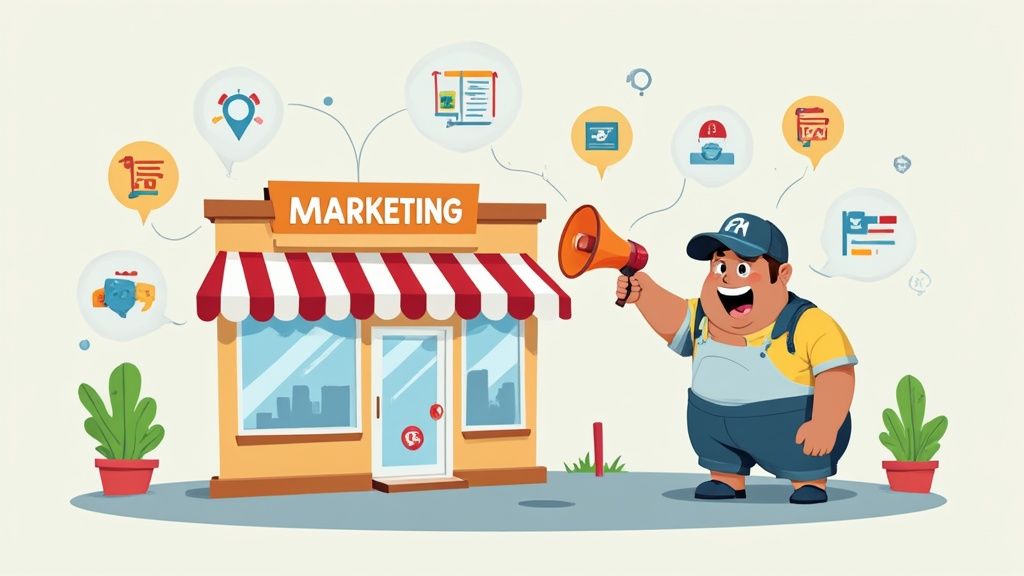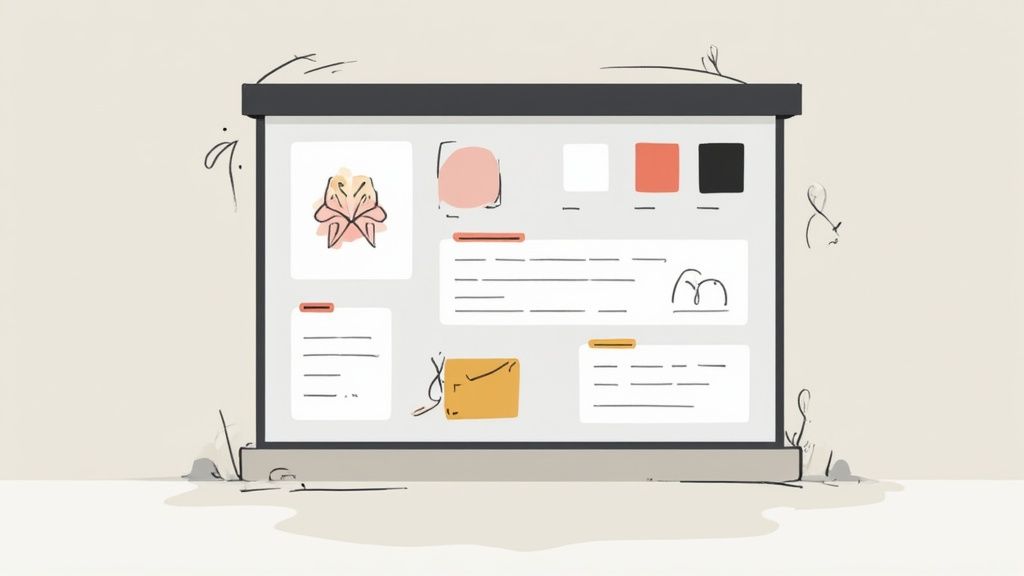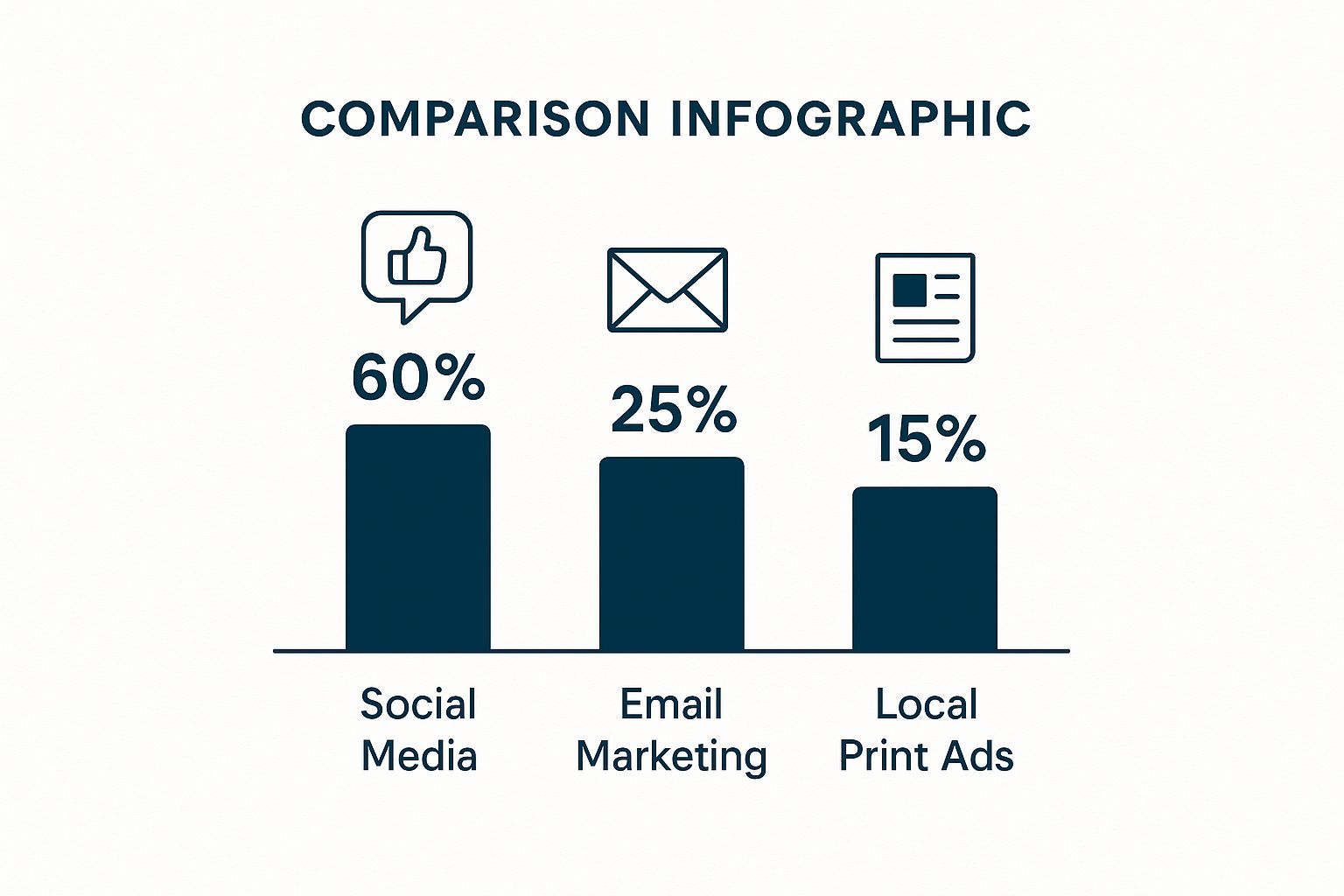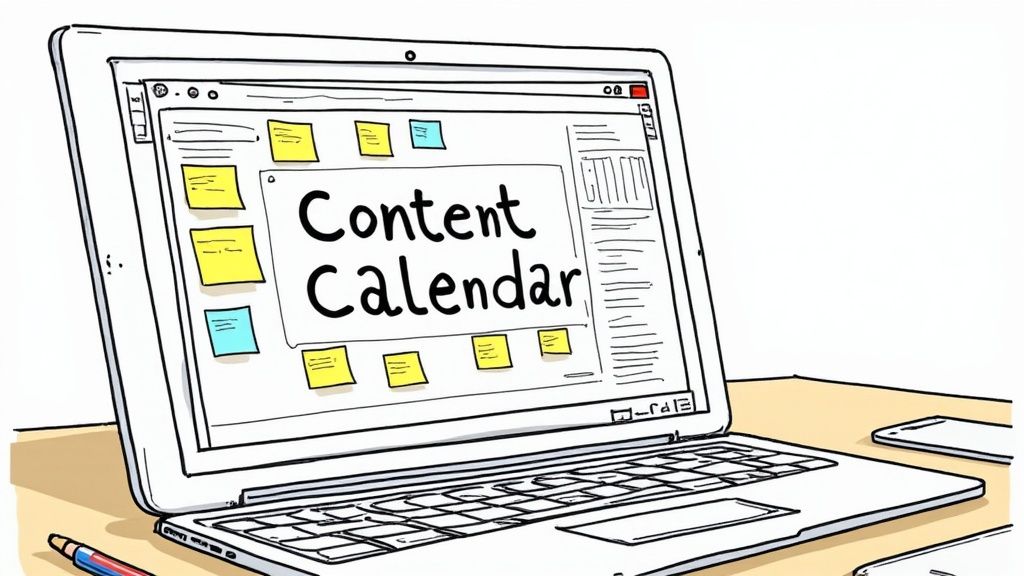Winning at marketing for a small business isn’t about who has the deepest pockets. It’s about being smarter, faster, and more in tune with your customers. Think of it as your secret weapon—the thing that lets you build real relationships and own a niche in a way the big corporations just can't.
This guide is your roadmap to turning that small size into a superpower.
Why Smart Marketing Is Your Greatest Advantage

Do you ever feel buried under all the marketing options out there? You’re not alone. So many small business owners see marketing as this giant, complicated expense. It's time to flip that script. Good marketing is the engine that actually drives your growth, connecting you straight to the people who are looking for exactly what you offer.
Unlike the corporate giants, you have a few tricks up your sleeve. You can adapt on the fly, let your personality shine through, and build genuine, one-on-one connections with your customers. These aren't just fluffy perks; they're what set you apart in a noisy market.
Turning Your Size Into a Superpower
Being small isn't a handicap—it's a strategic advantage. While the big guys are stuck in meetings and drowning in red tape, you can make a decision and act on it in minutes. That agility lets you test new ideas, respond to customer feedback almost instantly, and pivot your entire strategy without needing a dozen sign-offs.
To get the most out of this, you need to lean into powerful small business marketing strategies that play to your strengths.
This guide is built to be your practical, step-by-step playbook. We're skipping the buzzwords and focusing on real actions you can take to get results, without needing a massive budget. Forget trying to outspend your competition; we’re going to out-think them.
Marketing for a small business is less about outspending the competition and more about out-thinking, out-serving, and out-connecting them. It’s about building a community, not just a customer list.
The Growing Opportunity for Small Businesses
Small businesses are a massive force in the economy, and they're only getting bigger. The global small business market was valued at around USD 2,572 billion and is on track to nearly double, hitting an incredible USD 4,985 billion by 2032.
That explosion in growth means there's a huge opportunity waiting for entrepreneurs who can figure out how to connect with their audience. The market is expanding, and you can grab your piece of it.
Building Your Marketing Plan From the Ground Up

Jumping from a bunch of scattered ideas to focused, effective action all starts with a solid plan. Think of your marketing plan as the GPS for your business—it tells you where you’re going and the best way to get there, helping you dodge those expensive detours along the way. Without one, you're essentially just spending money and crossing your fingers.
A well-thought-out plan makes sure every dollar you spend and every decision you make has a clear purpose behind it. The best part? You don't need a huge team or a fifty-page document. You just need to be crystal clear on who you're trying to reach and what you want to accomplish.
Start With Your Ideal Customer
Before you even think about which social media platform to use or what your ads should look like, you absolutely have to know who you're talking to. The single biggest mistake in marketing for a small business is trying to be everything to everyone. It just waters down your message until it connects with no one.
Instead, take the time to build a detailed customer persona. This goes way beyond basic demographics. It's about sketching out a real person with real challenges, goals, and motivations. Give this person a name, a job, and a backstory. What problems are keeping them up at night? Where are they already looking for solutions?
Once you have that picture in your mind, every email, blog post, and ad you create will hit the mark because it speaks directly to their world.
Set SMART Goals for Your Marketing
Goals like "get more customers" sound nice, but they're impossible to measure and even harder to act on. You need specific, measurable objectives that tie directly back to your business growth. That's where SMART goals come into play.
SMART is an acronym that stands for:
- Specific: Nail down exactly what you want to accomplish. Instead of "increase sales," aim for something like, "increase online sales of our new product line by 15%."
- Measurable: You have to be able to track your progress with actual numbers. No guesswork allowed.
- Achievable: Be ambitious, but don't set yourself up for failure. Your goal should stretch you, not break you.
- Relevant: Does this marketing goal actually support your bigger business objectives? It has to.
- Time-bound: Give yourself a deadline. "By the end of Q3" creates a sense of urgency and a clear finish line.
Framing your goals this way transforms vague wishes into a concrete action plan. For a deeper dive, think about creating a documented playbook, like a winning small business social media strategy, to guide your growth.
A marketing plan without goals is like a ship without a rudder. You might be moving, but you have no control over your destination. Clear goals provide direction and purpose to every campaign you launch.
This isn't just theory; it's a proven approach. In fact, small businesses with a formal marketing plan are 6.7 times more likely to achieve success than those who just wing it.
Establish a Realistic Budget
Your budget is the fuel for your marketing engine. You don't need a massive one to get started, but you do need to be intentional with every dollar. Most small businesses find a sweet spot by dedicating between 6% and 10% of their revenue to marketing.
Start by jotting down all your potential expenses. This list will likely include things like:
- Website hosting and maintenance fees
- Email marketing software subscriptions
- Your monthly social media ad spend
- Content creation tools or hiring a freelancer
Once you have a budget, track your spending religiously. Even more important, track your return on investment (ROI). This simple step shows you which activities are actually making you money, so you can double down on what works and ditch what doesn't.
And don't forget, local visibility is everything for many small businesses. Our guide on https://lpagery.io/blog/google-business-profile-optimization/ is a great place to start maximizing your local impact without a huge spend. This simple framework—customer, goals, and budget—is the foundation for every single successful marketing strategy out there.
Choosing Your Most Powerful Marketing Channels
Once your plan is sketched out, the next big question pops up: where should you actually be marketing? It's so easy to fall into the trap of thinking you need to be everywhere at once—on every social media platform, running ads, sending newsletters, you name it. But that "spray and pray" approach is a surefire way to burn through your budget and your energy.
The secret to smart marketing for small business isn’t about being everywhere; it's about going deep where it counts. You'll get far better results by mastering one or two channels that your ideal customers actually use, rather than spreading yourself thin across ten. The goal isn't to do everything, but to do a few things exceptionally well.
For most small businesses, there's a powerful trio that consistently gets the job done: local SEO, email marketing, and social media. Together, they create a potent mix of long-term growth and immediate connection with your customers.
Aligning Channels With Your Business Goals
Before you jump into any specific channel, you have to connect it back to those SMART goals you set. Are you trying to get more people to walk into your physical store? Boost online sales? Or maybe you just need to book more consultation calls. Each of these goals points to a different marketing tool.
- To drive local foot traffic? Local SEO is non-negotiable. You have to show up when people in your neighborhood are searching for what you offer.
- To nurture interested leads? Nothing beats email marketing. It’s a direct line to people who’ve already raised their hand, letting you build trust over time.
- To build a community? Social media is perfect for showing off your brand’s personality, chatting directly with customers, and getting on the radar of new people.
Think of it like a toolkit. You wouldn't use a hammer to saw a piece of wood, right? Picking the right tool for the right job is the first step toward building something that will last.
The Power Trio of Small Business Marketing
While every business has its own unique needs, you'll find that local search engine optimization (SEO), email marketing, and platforms like Instagram or TikTok are often the most effective places to start. Getting these right often comes down to budgeting smartly. On average, small businesses put 7% to 10% of their yearly revenue toward marketing, and sticking to that range is strongly linked with getting great results.
This infographic gives a great snapshot of where small businesses are getting the most traction.

As you can see, digital channels like social media and email are crushing it, delivering way more bang for your buck than old-school print ads.
Focusing Your Efforts for Maximum Impact
Now, let's get practical. How do you decide where to focus your limited time and energy? You don't need to become an expert in all three at once. Just pick one to be your primary focus and another to support it.
-
Local SEO: The Foundation for Local Businesses. If your customers are in a specific geographic area, this is your #1 priority. It all starts with optimizing your Google Business Profile, gathering reviews, and creating content for your specific town or neighborhood. This ensures you’re the first one people see when they’re ready to buy. It’s a long-term play, but it builds a rock-solid advantage your competitors can't easily copy.
-
Email Marketing: The Relationship Builder. Here’s the thing about social media: you’re always at the mercy of the algorithm. But your email list? You own that. It’s a direct, personal way to talk to your audience. Use it to share helpful tips, announce sales, and turn casual leads into die-hard fans. An engaged email list is one of the most valuable assets any small business can build.
-
Social Media: The Community Hub. Don’t just sign up for everything. Go where your ideal customer already hangs out. If you’re a B2B consultant, LinkedIn is your spot. Running a cute clothing boutique? You’ll feel right at home on Instagram or Pinterest. The key is to create real, authentic content that helps people and starts conversations, not just a stream of sales pitches.
Your marketing channels are the bridges that connect your business to your customers. Choose the ones that are strongest and most direct, rather than trying to build a dozen flimsy bridges that lead nowhere.
Some businesses might also want to sprinkle in some paid advertising to speed things up. It requires a dedicated budget, but it can get you in front of people immediately and give you fast feedback on what messages are working. To see if it's a good fit, it's worth exploring the benefits of PPC advertising for small business owners.
Comparing Top Marketing Channels for Small Businesses
To help you visualize where you might fit, this table breaks down some of the most common channels. It’s a quick guide to help you decide where to invest your time and money based on your specific goals.
| Channel | Primary Goal | Typical Cost | Effort Level | Best For |
|---|---|---|---|---|
| Local SEO | Attract local customers | Low to Medium | High (upfront) | Brick-and-mortar stores, service-area businesses |
| Email Marketing | Nurture leads, build loyalty | Low | Medium | E-commerce, consultants, businesses with repeat customers |
| Social Media | Build community, brand awareness | Low to Medium | High (ongoing) | Visual brands, businesses targeting specific demographics |
| Content Marketing | Educate audience, build trust | Medium | High | B2B, service-based businesses, complex products |
| Paid Ads (PPC) | Generate immediate leads | High | Medium | Businesses needing quick results, e-commerce promotions |
Ultimately, the "right" marketing channels are the ones that feel sustainable for you and authentic to your brand. By choosing wisely and focusing on depth over breadth, you can create a powerful marketing engine that drives real, measurable growth for your business.
Mastering Local SEO to Win Nearby Customers

If you run a business with a physical storefront or a set service area—like a bakery, a plumbing company, or a local consultancy—then mastering local SEO isn't just a good idea. It's the most direct way to get in front of customers who are right around the corner and ready to make a purchase.
When someone in your neighborhood searches for "coffee shop near me," you need to be the first name that pops up.
Think of local SEO as your digital welcome sign. It's a fundamental piece of any smart marketing for small business plan because it makes you visible to the people who can actually walk through your door. This isn't about taking on global giants; it's about owning your backyard.
The best part? You can make a serious impact without a monster budget. It all starts with claiming your digital space and making it dead simple for search engines to understand who you are, where you are, and what you do.
Your Google Business Profile Is Your Digital Welcome Mat
Your Google Business Profile (GBP) is, without a doubt, the most powerful tool in your local SEO kit. It's that info box you see in Google Maps and local search results, dishing out your address, hours, photos, and customer reviews. It's completely free, and it’s often the very first impression a potential customer has of your business.
Keeping your GBP optimized is pretty straightforward, but it does need regular attention. A complete and active profile tells Google your business is legitimate, active, and relevant to local searchers.
To turn that profile into a real customer magnet, you need to nail these key areas:
- Fill Out Everything: Don't skip a single field. From your business category and service areas to accessibility info, fill it all out. The more details you give Google, the better it can match you with the right searches.
- Show Off with High-Quality Photos: Post clear, professional photos of your storefront, your products, your team, and your happy customers. Profiles with photos get a whopping 42% more requests for driving directions.
- Gather and Respond to Reviews: Make a habit of asking satisfied customers to leave a review. Then, make sure you respond to all of them—the good and the bad. It shows you're engaged and that you care about what your customers think.
A well-managed Google Business Profile does more than just list your information; it tells a story. Each review, photo, and answered question builds trust and makes a potential customer feel more confident choosing you over a competitor.
Building Local Citations for Credibility
Okay, so your GBP is dialed in. What's next? Making sure your business info is consistent everywhere else online. Local citations are simply mentions of your business's name, address, and phone number (often called NAP) on other websites like Yelp, TripAdvisor, or industry-specific directories.
Think of each consistent citation as a vote of confidence. When search engines find the same NAP information across dozens of reputable sites, it confirms that your details are accurate. That consistency is a huge trust signal that boosts your local search ranking. Inconsistent info, on the other hand, just creates confusion and can seriously ding your visibility.
Creating Location-Specific Content
Your website is another massive asset for local SEO. To pull in nearby customers, you have to create content that speaks their language. This means moving beyond generic service descriptions and building out pages specifically for the towns, cities, or even neighborhoods you serve.
For example, a plumber based in Chicago could create dedicated pages for "emergency plumbing in Lincoln Park" and another for "drain cleaning services in Wicker Park." This tactic does two things: it targets very specific search terms and shows potential customers that you're truly local and understand their area. For a complete walkthrough on this, our guide on how to do local SEO for small businesses is the perfect place to start.
This is where tools designed for creating pages at scale become a total game-changer. The screenshot below shows how LPagery lets you build hundreds of unique, location-specific pages from a single template, which can save you an unbelievable amount of time.

With a tool like this, even a one-person marketing team can build a powerful local footprint that targets dozens of different communities without spending weeks on manual work.
Creating Content That Genuinely Connects
Let’s be honest: effective marketing isn't just about picking the right channel. It's about what you say once you get there. Compelling content is what turns a casual browser into an engaged follower, and eventually, into a loyal customer. The good news? You don't need to be a professional writer or a video producer to make it work.
It all boils down to one thing: connection. As a small business, your authentic story is your greatest asset. Unlike some faceless corporation, you have a personality, a history, and a passion people can actually relate to. When you share that story—why you started, the problems you love to solve, the values you stand for—you build a level of trust that no amount of ad money can buy.
Turning Everyday Interactions into Valuable Content
The best content ideas are usually hiding in plain sight, right inside your customer conversations. Your audience is already telling you what they want to know. Your job is to listen and respond. Think of every question you get as a potential blog post, social media update, or quick video.
This approach guarantees your content is always relevant and helpful, positioning you as the expert who truly gets it. Here are a few practical ways to start:
- Answer Customer Questions: Take the top five questions you get in your inbox or on the phone. Turn each one into a detailed blog post. Not only does this provide immediate value, but it also creates a resource you can share with future customers.
- Create Simple How-To Videos: You don’t need a fancy camera—your smartphone is more than powerful enough. Film short, simple videos showing how to use your product or explaining a key concept related to your service.
- Showcase Customer Success: Share testimonials or short case studies that highlight how real people have benefited from what you offer. This kind of social proof is incredibly persuasive.
Crafting Messages That Capture Attention
Once you have a solid idea, the next step is to package it in a way that grabs attention. Whether it’s a blog title or a social media caption, the first few words are everything. You need a strong hook to stop people from scrolling right past.
Thankfully, you can lean on simple, proven formulas to craft compelling headlines and posts without all the guesswork.
Your content's primary job is to be so helpful and relatable that your audience feels understood. When you achieve that, the sale becomes a natural next step, not a forced pitch.
For example, a simple headline formula that works wonders is "[Achieve Desired Outcome] Without [Common Pain Point]." A personal trainer might use: "Build Strength in 15 Minutes a Day Without Going to the Gym." It’s direct, benefit-driven, and speaks to a specific problem.
Guiding Your Audience to the Next Step
Great content is pointless if it doesn’t lead anywhere. Every single piece you create, from a blog post to an Instagram story, must have a clear call-to-action (CTA). A CTA is just a simple instruction that tells your audience what to do next.
Without one, you leave people hanging. They might love your content but have no clue how to take the next step. Your CTAs should be direct, clear, and low-pressure.
- "Download our free guide to…"
- "Book a free 15-minute consultation today."
- "Shop the new collection now."
- "Leave a comment with your thoughts below!"
By consistently creating helpful content and pairing it with a clear CTA, you build a powerful system that guides potential customers on their journey with your brand.
Measuring Success Without Drowning in Data
Marketing without measurement is like shooting in the dark. For any small business, tracking your results isn't about becoming a data scientist—it's about knowing what's actually bringing in customers and what's just burning through your budget.
The goal here isn't to get lost in a sea of confusing charts. Instead, you'll want to zero in on a handful of Key Performance Indicators (KPIs) that tell you, plain and simple, if your marketing is working. This keeps things manageable and lets you make smart, quick decisions to improve your strategy.
Identifying the Metrics That Matter
You don't need to track dozens of different numbers. For most small businesses, a few core metrics will give you a clear snapshot of your marketing's health. Think of them as the vital signs that show you're on the right track.
Start by focusing on these three essentials:
- Website Traffic Sources: This tells you how people are finding you. Are they coming from a Google search? A specific social media channel? Your email newsletter? Knowing where your visitors come from helps you double down on what’s working.
- Conversion Rate: This is the percentage of your website visitors who take the action you want them to, like filling out a contact form or buying a product. It’s the ultimate report card on how compelling your website and messaging really are.
- Customer Acquisition Cost (CAC): Simply put, this is how much you spend on marketing to get one new customer. Calculating your CAC helps you understand the direct financial return on your marketing spend and keeps your efforts profitable.
Tracking marketing isn't about collecting data for its own sake. It's about connecting your actions to real-world results, like a new lead or a sale. That connection is what turns marketing from an expense into a predictable engine for growth.
A Simple Review Process
You can use free tools like Google Analytics to set up a simple dashboard to watch these key metrics. You don't have to live in the data, either. A quick weekly or monthly check-in is usually enough to spot trends and make necessary tweaks.
For a deeper dive into which numbers to watch, our guide to SEO analytics offers a more detailed roadmap. This focused approach keeps your marketing for your small business on track and ensures you’re getting measurable results.
Your Small Business Marketing Questions Answered
Even with the best plan in hand, you're going to have questions. It’s just part of navigating the marketing world, especially when you’re running a small business. I’ve put together some quick, straightforward answers to the questions I hear most often to help you stay on track and make decisions with confidence.
Think of this as your go-to guide for those "am I doing this right?" moments. These answers build on the core ideas we've already covered and give you practical advice you can use right away.
How Much Should a Small Business Spend on Marketing?
You'll often hear the benchmark of 7-10% of your annual revenue. It's a decent starting point, but it’s definitely not a hard-and-fast rule. If you're a brand-new business just trying to get your name out there, you might need to lean in a bit harder and invest a higher percentage to build that initial momentum.
The biggest mental shift is to stop seeing marketing as just an expense. It's a strategic investment in growth. Start with a budget that feels manageable, then track your return like a hawk. Once you see which channels are actually bringing in customers, you can confidently double down on what’s working.
Should I Do My Own Marketing or Hire Help?
Plenty of small business owners handle their own marketing, especially in the beginning. It’s a great way to learn the ropes and keep costs down. The secret is to avoid spreading yourself too thin. Pick one or two channels that really fit your business and focus on mastering them. You can get fantastic results without feeling completely overwhelmed.
But there will come a time when doing it all just doesn't make sense anymore. If you find marketing tasks are constantly pulling you away from the core of your business, or you've hit a growth ceiling and can't seem to break through, it’s probably time to get some help.
Your time is your most valuable asset. If marketing is eating up too much of it without a clear return, outsourcing becomes a smart investment in your own efficiency and your company’s growth.
You don't have to go from zero to a full-blown agency overnight. A hybrid approach often works best for a small business. You could:
- Hire a Freelancer: Bring in a specialist for a specific task, like dialing in your local SEO or running a social media ad campaign.
- Work with a Consultant: Get an expert to look over your shoulder and help you refine your overall marketing plan.
- Partner with an Agency: When you're ready to scale up and manage multiple channels at once, a full-service agency can take the lead.
What Is the Single Most Important First Step in Local Marketing?
For almost any business serving a local community, this one is a no-brainer. The most critical first step is to claim and completely fill out your Google Business Profile (GBP). It is, hands down, the highest-impact thing you can do for your local visibility, and the best part is it's completely free.
Think about it: your GBP is often the very first impression a potential customer gets of your business. A profile that’s packed with great reviews, accurate hours, fresh photos, and regular updates acts like a powerful magnet, pulling in foot traffic and phone calls right from Google Search and Maps. It’s the absolute foundation of any successful local marketing strategy.
Article created using Outrank


